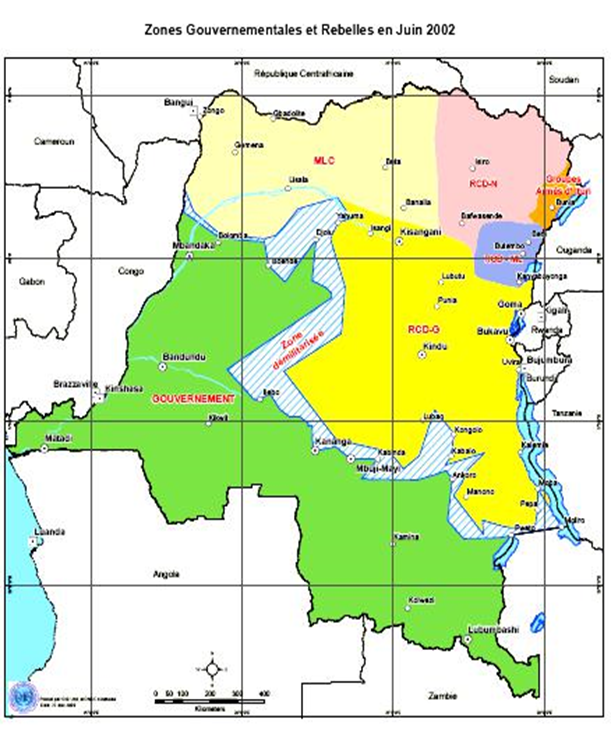Mapping Report > Section I. Inventory of the most serious violations > CHAPTER IV. January 2001–June 2003: Towards Transition
Following the assassination of Laurent-Désiré Kabila on 16 January 2001 and his replacement by his son Joseph Kabila, a new phase of the conflict began. The belligerents agreed to implement a plan to withdraw their forces and start preparing for the Inter-Congolese Dialogue (ICD). From March 2001 onwards, MONUC’s military observers were able to be deployed along the front line and consolidate the ceasefire.
In the provinces of North and South Kivu, however, the war continued between Kabila’s Government (the Mayi-Mayi groups, FDD and ALiR) and the soldiers of the ANC, (the armed wing of the RCD-Goma), and the Rwandan soldiers of the APR.
In Orientale Province, the efforts made by Uganda to unite its two allies, the RCD-ML and the MLC, failed. After the RCD-ML rallied to the Government in Kinshasa, the ALC (the army of the MLC) and the ANC stepped up their attacks on the army of the RCD-ML, the APC. The attacks were designed to prevent the government army of the FAC from regaining a foothold in North Kivu and Orientale Province through its new ally, the RCD-ML.
In spite of reluctance on both sides, the Inter-Congolese dialogue began on 25 February 2002 in Sun City (South Africa). On 19 April, President Joseph Kabila and the head of the MLC, Jean-Pierre Bemba, announced the conclusion of a framework power-sharing agreement for which they gained the support of most of those involved in the Dialogue, except the RCD-Goma and several parties from the unarmed political opposition, including the UDPS.
On 30 July 2002, the Congolese and Rwandan Presidents signed a peace agreement in Pretoria, providing for the withdrawal of Rwandan troops from Congolese territory in return for the dismantling of the ex-FAR/Interahamwe and Hutu armed groups within the Forces démocratiques de libération du Rwanda (FDLR698).699 At the same time, the Government in Kinshasa concluded a peace agreement with Uganda in Luanda on 6 September, providing for the withdrawal of Ugandan troops from the Congo and the re-establishment of peace in the Ituri district.700 Starting in September 2002, Zimbabwean, Angolan, Namibian, Rwandan and Ugandan troops began to withdraw from Congolese territory. Under intense international pressure, the various elements and entities involved in the Inter-Congolese Dialogue finally signed the Global and All-Inclusive Agreement in Pretoria on 17 December 2002.701 In spite of the continued fighting in North and South Kivu, the deterioration in the security situation in North
Katanga and the intensification of the war between the different militias in Ituri, the participants in the Inter-Congolese Dialogue ratified the Global and All-Inclusive Agreement in Sun City (South Africa) on 1 April 2003 along with an additional memorandum on the integration of the various armed groups into a single national army. The transition institutions were officially put in place on 30 June 2003.

698 The ALiR was dissolved as part of the FDLR at the end of 2000.
699 For the text of the Agreement, see S/2002/914, appendix.
700 Available at the following address: www.droitcongolais.info/files/0426_accord_du_6_septembre_2002_ rdc-ouganda_r.pdf.
701 Available at the following address: http://democratie.francophonie.org/IMG/pdf/VII.1.pdf.

